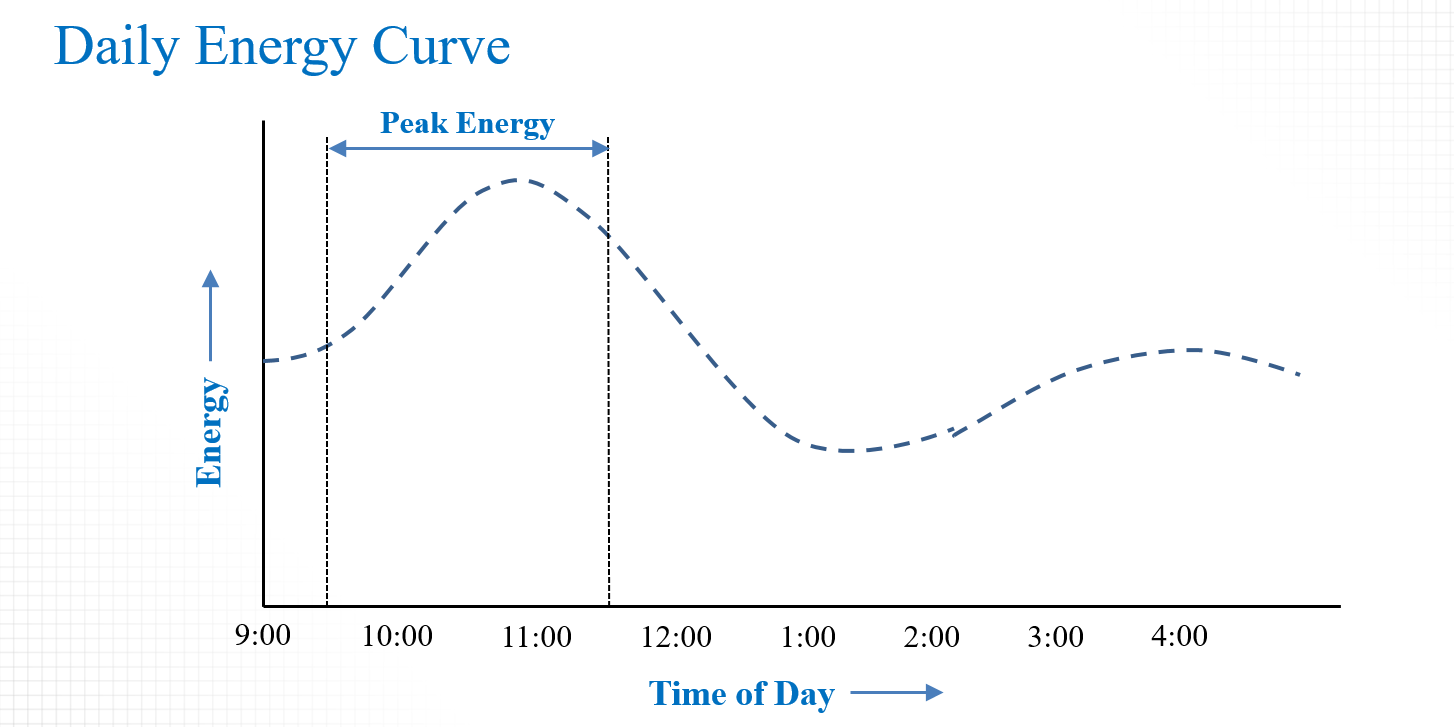If you are generally new to working from home on a full-time basis, we at the University of Maryland’s Project Management Center for Excellence have put together a few ideas that may be useful.
Routine
It is best to develop a schedule and routine that works for you. Treat the day like a workday and get up on time, dress for the office (even if it is casual) and try to keep a regular schedule.
- Plan your day to work with your natural energy cycle. We all have one and they are different. Maybe you are a morning person or a night owl or something in between. Your curve may look something like this:

In any case, schedule your focused work during your peak energy cycle and do things that require less focus during low energy times. This is a natural cycle but can be influenced by diet and exercise. Eat some protein when you need to push through a low energy time to finish a task.
- Take breaks at whatever interval works for you, even if it’s just getting a fresh coffee and walking around the house for a minute.
- Be sure to change your field of vision and focal length when you take a break. If you are sitting at a computer doing your work, make sure to look out the window or go outside so you are looking at a distance.
- Forget the 8-10 hour typical day in the office and don’t be afraid to take breaks for personal things you need to get done. Working from home means you actually have a much longer workday!
- Stay in contact with work colleagues and friends by scheduling video conferences. We actually do virtual cocktail parties with friends a few times a week to stay in touch and schedule regular “catch-ups” with work colleagues.
- Coordinate with family members so they understand and accommodate.
Environment
You need a regular place to work. So, even if you do not actually have dedicated office space at home it is important to create it. Some things to consider include:
- Find a quiet room with a door that closes.
- If you are sharing workspace or have other noise distractions, noise cancelling headsets are very useful.
- Have comfortable seating and lighting and do your best to create a pleasant workspace.
- If you don’t already have it, spend the money to have an excellent internet connection, laptop or desktop computers with camera for video conferencing. We like the Logitech HD Pro Webcam C920. I find that having at least two monitors improves production significantly. Having a good quality printer & scanner saves a lot of time. Get a wifi booster if needed to keep a strong signal. We like the eero home wifi system but there are several good ones on the market.
- Find a place to store extra supplies such as paper and print cartridges so you don’t have a crises when something runs out. Make sure you order replacements way before you think you will need them. We have separate guidance on video conference etiquette and facilitating video conferences.
Take Care of Yourself
Lastly, it is very important to continue to do the basics. Make sure you exercise regularly, even if it is only going for a walk, but hopefully something more like stretches and light weights. Make sure to eat well and do not revert to junk food, and certainly get enough sleep. Finally, block out some time for yourself for reflection. I hope these tips trigger some ideas for you.
This article appeared in PM World Journal, Vol. IX, Issue VII, July 2020.

John Cable, Director, Project Management Center for Excellence, University of Maryland
How to cite this article: Cable, J. H. (2020). Converting to Online Teaching: A Series of short guidance articles for educators and institutions – Tips for Working at Home, PM World Journal, Vol. IX, Issue VII, July.
Posted by David on July 8, 2020

 Data Analytics for the Project Manager
Data Analytics for the Project Manager